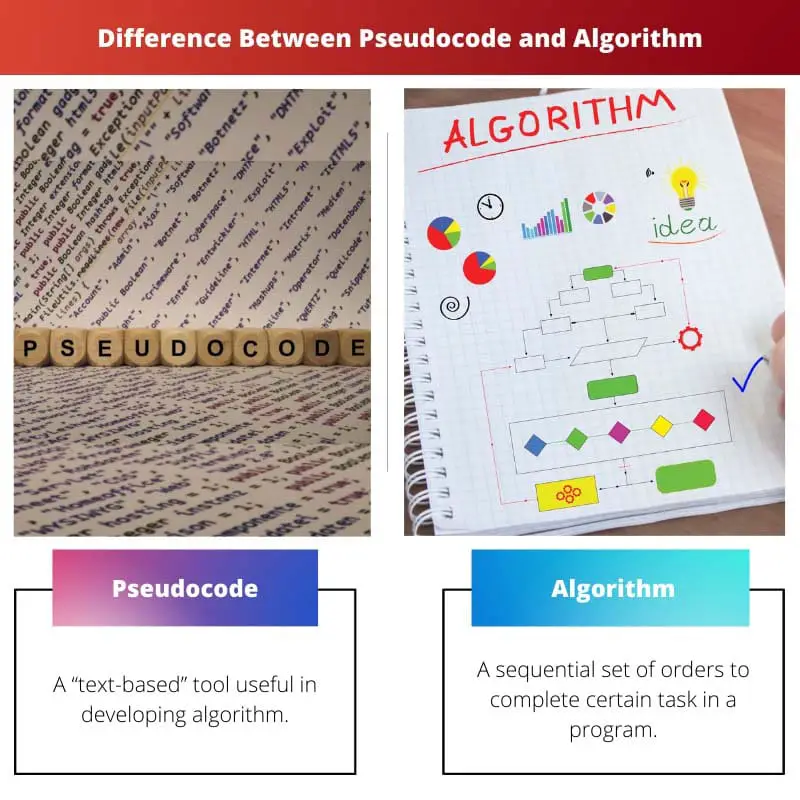Living in a digital world, most of our work is computerized. Behind every function, application, or software, there are a bunch of computer instructions or programs written by programmers in specific programming languages.
Key Takeaways
- Pseudocode is a simplified programming language used to describe an algorithm, while an algorithm is a step-by-step procedure for solving a problem.
- Pseudocode is not an actual programming language, while an algorithm can be implemented in any language.
- Pseudocode is used for planning and communication, while algorithms are used in software development.
Pseudocode vs Algorithm
Pseudocode is a tool that helps users understand the flow of a program. It aims to simplify programming language for users unfamiliar with this domain. An algorithm is a series of instructions carried out in a specific order to produce a desired outcome. The steps are clearly defined and unambiguous.

Pseudocode is a tool to create the entire flow of the program. It is helpful, especially while explaining a new project to programmers.
While algorithms are steps, it contains specific selections, sequences, and iterations. It can analyze every problem and develop an approach to solve the issue.
Comparison Table
| Parameters of comparison | Pseudocode | Algorithm |
|---|---|---|
| Definition | A “text-based” tool useful in developing algorithm | A sequential set of orders to complete certain task in a program |
| Aim | To simplify the programming language so that humans can understand without having prior knowledge about programming language | To help in performing the task and get the desired output through defined steps |
| Characteristics | Clear beginning and end, usage of named variables and identifiers | Clear, unambiguous, defined input and output, language-independent and feasible |
| Advantages | Use of simple English language, designs the entire flow of the program, and can be easily converted to actual programming code | Step-wise representation which is simple and easy to understand and executes on available resources |
| Disadvantages | It cannot be compiled or executed and every designer has a different style of writing pseudocode | Time-consuming and certain branch and loop statements are difficult to depict in algorithm |
What is Pseudocode?
Pseudocode is a way of describing an artificial program language. It helps in developing algorithms. Pseudocode can also be referred to as a design tool that is “text-based”.
Pseudocode is useful in planning the algorithm before coding and provides a sketch or outline of the program. The entire flow and summary of the program are created in pseudocode.
Since pseudocode is not a programming language, it cannot be compiled or executed. It does not use proper syntax or code but more terms of the English language. Through pseudocode, flow errors can be identified.
The program description and function are the basis for creating pseudocode. Any error in the flow of the program is easy to correct during pseudocode.
What is Algorithm?
The algorithm is a step of the sequential procedure that is used to solve a problem. It includes actions that need to be executed and even the order of the actions.
The algorithm is unambiguous. Tasks like automated reasoning, calculations and data processing can be performed using algorithms.
The word algorithm is derived from the name of a renowned mathematician, Muhammad Ibn Mūsā al-Khwārizmī. The algorithm has existed since ancient times.
A prototypical example is that of the Euclidean algorithm, which determines the maximum common divisor of two integers.
Main Differences Between Pseudocode and Algorithm
- Pseudocode offers an explanation of the algorithm, while the algorithm offers the solution for the problem statement.
- Pseudocode is helpful in comprehending the idea of the program, while the algorithm is helpful in comprehending the execution of the program.




